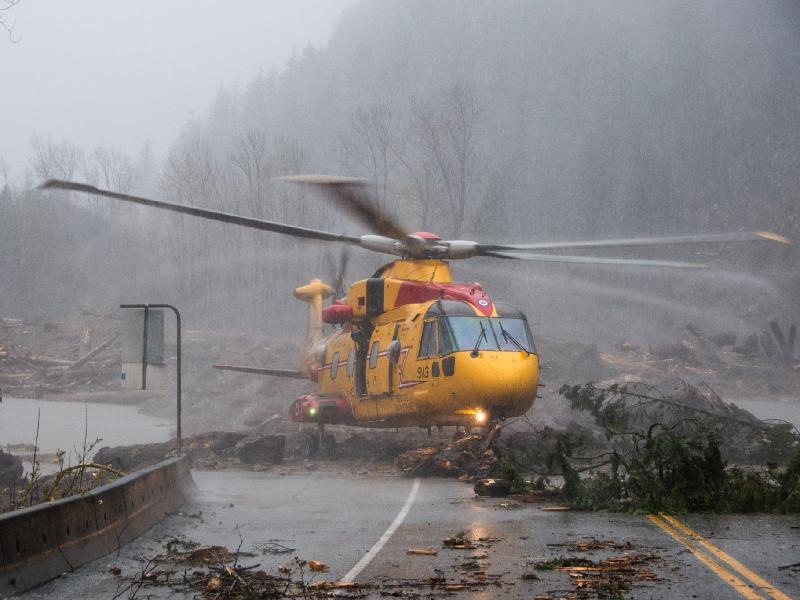Photos: The catastrophic damage that severed B.C. from the rest of Canada
By: Tristin Hopper (MSN)



For one of the only times since the completion of the Canadian Pacific Railroad in 1885, every single Canadian land route to the Pacific has been cut. Extreme rains brought a series of devastating floods and landslides that have severed the Trans Canada Highway, the Coquihalla Highway and both major rail lines over the Rocky Mountains. Unstable conditions have also forced the closure of the Trans Mountain pipeline and critical gas pipelines serving the City of Vancouver.
© Provided by National Post An RCAF Cormorant pictured in the midst of an operation to free more than 311 people (and 26 dogs) who became stranded near Agassiz, B.C. when landslides washed out roads on both sides of them.
The coming days are poised to yield any number of supply chain crises across Western Canada; bare grocery store shelves in Kelowna, backed-up grain shipments throughout the prairies and gasoline shortages across Vancouver Island and the Lower Mainland. But as Canada grapples with the economic storm from the disaster in B.C., here is a gallery of photos - all of them taken by agencies at the front lines of the response - showing just what B.C. is dealing with.
Highway crews assess the damage wrought by a landslide along Highway 7, one of two road links connecting Vancouver to Hope, B.C. and communities beyond. This was actually among the less destructive washouts B.C. suffered on Monday. Barring any removal of the asphalt, this is the kind of blockage that can feasibly be pushed aside by a handful of excavators. As shown below, many washouts didn't just scour roads from the map, but utterly reshaped the terrain on which they used to lie.
The Tank Hill Railroad Bridge featured in the above photos was never supposed to span a waterway. But that's the current scene after mudslides completely obliterated the section of Trans Canada Highway that usually runs underneath it, leaving the Tank Hill Railroad Bridge clinging to life above an impromptu rush of floodwaters. This all occurred near Lytton, B.C., the village that was almost destroyed by fire in June only hours after setting Canada's highest temperature recorded.
This is the view from the back of an RCAF Cormorant helicopter as crews from 442 Transport and Rescue Squadron rescued 311 people (as well as 26 dogs and a cat) after their cars became trapped between landslides near Agassiz, B.C., a community at the eastern edge of the Fraser Valley.
Somewhere under there is the Trans-Canada Highway as it runs through Abbotsford, just one hour east of Downtown Vancouver (the overpass forming part of the Whatcom Road turnoff is visible at the top right). Abbotsford is a center of Canadian poultry farming, with the result that rising floodwaters have left whole barns filled with thousands upon thousands of drowned chickens and turkeys. On Tuesday night, a large swath of Abbotsford was ordered to immediately evacuate after civic officials warned that the failure of a critical pumping station could lead to the "catastrophic" reformation of Sumas Lake, a body of water drained in the 1920s whose former footprint is now home to hundreds of homes and farms. "Residents need to abandon their efforts to save livestock, ignoring current orders in place and to leave the area immediately," read the order .
Load Error
High winds caused this barge to break free and slam into Vancouver's Sunset Beach, where it remained as of Wednesday morning, immune to attempts to remove it via tugboat. Although the escaped barge quickly generated jokes that it was Vancouver's " hottest new night club " or a welcome addition of new real estate, the loose boat briefly threatened to slam into the Burrard Street Bridge on Monday, forcing the span's closure.
In this photo, members of Pemberton Search and Rescue make their way over a washed out section of the Sea to Sky Highway just north of Whistler, B.C. It was this slide that would claim the first confirmed victim of the B.C. flooding. Between five and seven cars were pushed off the highway by the rush of mud and debris. As of Wednesday, RCMP have confirmed the death of one of the drivers, a woman from the Lower Mainland.
It's on the Coquihalla - the northern highway roughly connecting the Lower Mainland to Northern Alberta - that the most dramatic damage was suffered on Monday. In the photo at left (which was widely shared across B.C. social media) the rising floodwaters of the Coldwater River have effectively erased a section of road from existence. The photo at right shows another view, with the highway's eastbound lane now coming to a jagged stop over a sheer chasm formed by the floods. When B.C. Deputy Premier Mike Farnworth said it would take "weeks or even months" to restore the Coquihalla to full operations, it was after getting briefed on damaged like this.




Click on ''Seeded Content'' to view the photos of the devastation in B.C.
I just did. I've been following this on the CTV NEWS (Canada Television News). I always knew of the disdain of a lot of people in B.C. for us back in the east, desiring to separate from the rest of Canada like the Quebecois tried to do, but I don't think they really wanted it to happen this way. Fortunately they can still receive necessities by air transport.
So horrible. I know how remote the eastern part of BC is and with no passage from the coast to the interior people will be hurting for supplies.
The devastation is tragic
Seems that the damage is unprecedented with all roads/rails severed.
pay to reduce global warming, or pay for the effects of it...
That sure seems to be the way.
How do you pay to reduce something that is inevitable?
why not supply your kids with cigarettes, booze, and heroin since they're going to die anyway?
Not quite the response I was expecting, but anyways, what do you believe are the signs of a coming ice age?
Did you watch the movie The Day After Tomorrow?
Yes I've watched it several times, the whole movie is based on the mammoth found in the permafrost with food in its mouth and scientists making the false assumption that it froze instantly, of course they are wrong. The same assumption is that an ice age means the climate has to get colder and that would also be wrong.
republicans getting back congress and the white house.
I see this will not be taken seriously.
Without a serious discussion on another possible reason why the extreme weather events are occurring, I guess I'm done here.
I haven't taken no compromise and obstructionist republicans seriously since 1968.
Nixon - criminal
Ford - lapdog
Reagan - dementia poster boy
Bush Sr. - drug kingpin
Bush Jr. - moron
Trump - traitor
Hopefully we and other countries step in to try to help.
It's going to be a long expensive road to recovery, Paula.
What a horrible mass of devastation. Not only for the people who live there, but, for the wildlife and environment as well.
The Northwest has been inundated with back to back storms, and such devastation will not be easily repaired, if even possible.
But, the damage suffered by BC will have a huge impact on the rest of the interior of Canada for some time as well.
My heart goes out to those who have lost everything, and whose lives will be adversely affected for some time to come.
The photos were shocking to say the least.
I would think that the photos at this point show only the tip of the iceberg of the overall devastation, with much worse devastation to be seen as access is presented.
And as you said up thread, the clean up will take a very long time. And there are more storms coming that way, which could make things even worse.
Here is a link to ranchers trying to save their cattle from drowning.
My heart goes out to the farmers, and the poor, frightened animals. Especially, the small calves that are too small to fend for themselves in the deep water that is over most of their heads.
And that does not mention the other animals whose lives are at stake due to the high flood waters. To get that much rain in such a short span of time, on top of the already rain soaked terrain, it was a true disaster waiting to happen.
It is really great that the farmers and ranchers are all coming together to help each other to rescue their animals and save what they can before the next storm moves in.
Thank you for the link.
I just read another story on the cattle and it's getting much worse, in addition to cattle there are horses, dogs, cats, chickens etc etc.
It would be great if some of the rescue organizations in Washington, Idaho and Montana could send in their people to lend a hand to help as much as possible before the next storm hits, or, the pumping station stops working. It may not be possible to save all the animals, but, hopefully, they can save as many as they can.
And that does not include the wildlife in the areas. Cats can swim and hopefully find a tree to climb to wait for help, but, other animals may not be so fortunate to find a safe place to wait for help.
That is a really terrible situation. I hope it all works out soon.
It's getting worse and if the one pumping station fails thousands of cattle and other animals will be killed.
It is a horrible situation.
OMG, I just finished looking at those photos and it is mind-boggling.
That is going to take years to recover from. And right now, all those people living in the path of that destruction... where are they going to go?
Holy extreme weather.
Extreme weather is an understatement.